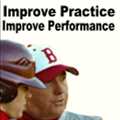Youth Baseball Drills - It's Not Aerobics
Nate Barnett
I was watching a little bit of a little league baseball practice last week and couldn't help but notice the speed in which
the players were working on their baseball drills. It was like watching a video tape in fast forward. Kids were scrambling
everywhere, harried coaches were issuing directives like it was a battle scenario and his "troops" were under fire. I couldn't
believe it. There is a fine line between efficient practice and aerobic practice. I'll explain both below.
Aerobic Practice: Practicing at the pace where the focus becomes quantity rather than quality.
This form of practice, much like the example in the opening paragraph, is employed usually because coaches feel that it's
important to keep athletes moving around when working on youth baseball drills. The more players stand around, the less productive
they are is the thought. While I agree that many times there are giant chunks of time wasted and unused in many practices,
baseball aerobics is not the answer.
If this strategy is employed, many younger kids will begin to shift their focus from learning and developing to hurrying
and scurrying. Little effective baseball instruction can occur at this pace.
Efficient Practice: Practicing with the focus on organization, precision, and fluidity.
Good coaches understand that this is the ONLY option to building a successful team. It's a balanced approach between speed
and precision of instruction. There a many different ways this style plays out in real time, but let me illustrate with the
example my college coach used.
Practice would begin promptly on time. Meaning, all athletes were fully geared up, prepared, and waiting for coach to say
"go" at the time practice was slotted to begin. Every day practice plans were posted in the locker room for us to see prior
to practice. They were complete with times and additional notes for directing the focus of the day. Once practice began, everyone
had an idea of what was being worked on that day as well as individual responsibilities for taking care of gear, cleaning
up the field, etc.
After we started, coach would move us around based upon time. After 20 minutes we may move from our live full team defensive
drills and break into our designated infield and outfield groups to work on different skills. This type of scheduled work
would continue for the remainder of the practice. During these timed pockets we knew we needed to be efficient before we moved
on. However, because the focus was on precision and not speed, we got a ton accomplished. Coach would circulate and work with
different groups (or our team as a whole) in a relaxed fashion and spend the necessary time needed to work on skill development.
I would strongly encourage you if you coach to work on and put in place the strategy of an efficient and well oiled practice
without attention on speed. Your athletes, and parents will love you for it.
Nate Barnett is owner of BMI Baseball http://bmibaseball.com and is based out of Washington State. His expertise is in
the area of hitting, pitching, and mental training. Coach Barnett's passion is working with youth in helping expand their
vision for their baseball future. After finishing a professional career in the Seattle Mariners Organization, Nate pursued
his coaching and motivational training career. His instructional blog is located at http://bmibaseball.com/blog
His new FREE ebook, Toxic Baseball: Are you polluting your game? can be found on the main BMI Baseball website.
Hitting 101, an ebook on complete hitting mechanics will be released by June 1st, 2008. Features include numerous illustrations,
video clips, and a special offer to discuss your hitting questions over live on the phone strategy sessions.

